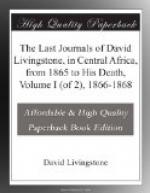2nd May, 1866.—Mountains again approach us, and we pass one which was noticed in our first ascent from its resemblance to a table mountain. It is 600 or 800 feet high, and called Liparu: the plateau now becomes mountainous, giving forth a perennial stream which comes down from its western base and forms a lagoon on the meadow-land that flanks the Rovuma. The trees which love these perpetual streams spread their roots all over the surface of the boggy banks, and make a firm surface, but at spots one may sink a yard deep. We had to fill up these deep ditches with branches and leaves, unload the animals, and lead them across. We spent the night on the banks of the Liparu,[9] and then proceeded on our way.
3rd May, 1866.—We rested in a Makoa village, the head of which was an old woman. The Makoa or Makoane are known by a half-moon figure tattooed on their foreheads or elsewhere. Our poodle dog Chitane chased the dogs of this village with unrelenting fury, his fierce looks inspired terror among the wretched pariah dogs of a yellow and white colour, and those looks were entirely owing to its being difficult to distinguish at which end his head or tail lay. He enjoyed the chase of the yelping curs immensely, but if one of them had turned he would have bolted the other way.
A motherly-looking woman came forward and offered me some meal; this was when we were in the act of departing: others had given food to the men and no return had been made. I told her to send it on by her husband, and I would purchase it, but it would have been better to have accepted it: some give merely out of kindly feeling and with no prospect of a return.
Many of the Makoa men have their faces thickly tattooed in double, raised lines of about half an inch in length. After the incisions are made charcoal is rubbed in and the flesh pressed out, so that all the cuts are raised above the level of the surface. It gives them rather a hideous look, and a good deal of that fierceness which our kings and chiefs of old put on whilst having their portraits taken.
4th May, 1866.—The stream, embowered in perpetual shade and overspread with the roots of water-loving, broad-leaved trees, we found to be called Nkonya. The spot of our encampment was an island formed by a branch of it parting and re-entering it again: the owner had used it for rice.
The buffaloes were bitten again by tsetse on 2nd, and also to-day, from the bites of other flies (which look much more formidable than tsetse), blood of arterial colour flows down; this symptom I never saw before, but when we slaughtered an ox which had been tsetse bitten, we observed that the blood had the arterial hue. The cow has inflammation of one eye, and a swelling on the right lumbar portion of the pelvis: the grey buffalo has been sick, but this I attribute to unmerciful loading; for his back is hurt: the camels do not seem to feel the fly, though they get weaker from the horrid running sores upon them and hard work. There are no symptoms of tsetse in mules or donkeys, but one mule has had his shoulder sprained, and he cannot stoop to eat or drink.




